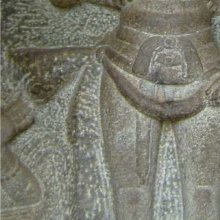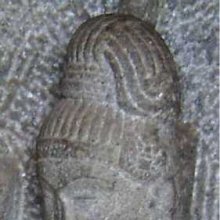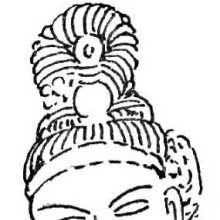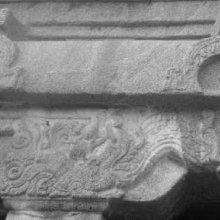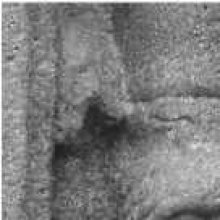Trimurti, Trimūrti, Tri-murti: 17 definitions
Introduction:
Trimurti means something in Hinduism, Sanskrit, the history of ancient India, Marathi. If you want to know the exact meaning, history, etymology or English translation of this term then check out the descriptions on this page. Add your comment or reference to a book if you want to contribute to this summary article.
Images (photo gallery)
(+20 more images available)
In Hinduism
Shilpashastra (iconography)
Source: Archaeological Survey of India: Śaiva monuments at Paṭṭadakal (śilpa)Trimūrti (त्रिमूर्ति) is depicted as a sculpture on the third pillar of the southern half of the maṇḍapa of the temple of Lokeśvara.—This pillar, like others, is decorated with episodes from various Purāṇic and literary sources. In the main register below the semi-circular medallion, is shown the divine Triad seated in the following order, left to right.
1) Seated in padmāsana “on a lotus throne,” three headed Brahmā is in a yogic posture with a yogapaṭṭa, yogic band, passing around his two knees together. His two hands are held upwards, suggesting some gestures, not much clear. He wears hāra, a garland which may be made of rudrākṣa beads “eyes of Rudra”. He is attended by a caurī bearer.
2) In the centre of the panel is seated Śiva with his consort Umā, on a large throne. With his upper left hand he is giving a loving touch to his consort’s chignon with extreme tenderness. It is very interesting to note that a liṅga is placed in the palm of his left hand held at the level of his heart. Probably he is showing his Ātmaliṅga to his consort. Of the two right hands, the lower one is on his thigh, whereas the upper one makes a gesture of holding something, probably a trident or a deer. By the side of the goddess stands a caurī bearers.
3) In the third place, to the extreme right is seated Viṣṇu with a yogapaṭṭa, tied around his waist and his right leg poses resting on a throne. Of his four hands, the conch and the discus are in the upper right and left, respectively. The lower right rests on his thigh and the corresponding left is in dola, hanging, passing by the side of his knee. A caurī bearer is standing by whose side is a lady seated holding his right hand near her mouth. It is customary to hold hands near the mouth for secondary personages to avoid the sprinkling of saliva on their interlocutor.
Source: Shodhganga: Iconographical representations of Śiva (shilpa)Trimūrti (त्रिमूर्ति) or simply Tri refers to one of the ten forms (mūrti) of Śiva mentioned in the Ajitāgama (under the Maheśvararūpa heading): the fifth among the Siddhāntaśaivāgamas. The forms of Śiva (e.g., Tri-mūrti) are established through a process known as Sādākhya, described as a five-fold process of creation.

Shilpashastra (शिल्पशास्त्र, śilpaśāstra) represents the ancient Indian science (shastra) of creative arts (shilpa) such as sculpture, iconography and painting. Closely related to Vastushastra (architecture), they often share the same literature.
Ayurveda (science of life)
Rasashastra (Alchemy and Herbo-Mineral preparations)
Source: Wisdom Library: Rasa-śāstraTrimūrti (त्रिमूर्ति) or Trimūrtirasa is the name of an Ayurvedic recipe defined in the fourth volume of the Rasajalanidhi (chapter 3, grahaṇī: chronic diarrhoea). These remedies are classified as Iatrochemistry and form part of the ancient Indian science known as Rasaśāstra (medical alchemy). However, since it is an ayurveda treatment it should be taken with caution and in accordance with rules laid down in the texts.
Accordingly, when using such recipes (e.g., trimūrti-rasa): “the minerals (uparasa), poisons (viṣa), and other drugs (except herbs), referred to as ingredients of medicines, are to be duly purified and incinerated, as the case may be, in accordance with the processes laid out in the texts.” (see introduction to Iatro chemical medicines)

Āyurveda (आयुर्वेद, ayurveda) is a branch of Indian science dealing with medicine, herbalism, taxology, anatomy, surgery, alchemy and related topics. Traditional practice of Āyurveda in ancient India dates back to at least the first millenium BC. Literature is commonly written in Sanskrit using various poetic metres.
Shaivism (Shaiva philosophy)
Source: Shodhganga: Iconographical representations of ŚivaTrimūrti (त्रिमूर्ति) is the name of a deity who received the Dīptāgama from Īśa through the mahānsambandha relation, according to the pratisaṃhitā theory of Āgama origin and relationship (sambandha). The dīpta-āgama, being part of the ten Śivabhedāgamas, refers to one of the twenty-eight Siddhāntāgamas: a classification of the Śaiva division of Śaivāgamas. The Śaivāgamas represent the wisdom that has come down from lord Śiva, received by Pārvatī and accepted by Viṣṇu.
Trimūrti obtained the Dīptāgama from Īśa who in turn obtained it from Sadāśiva through parasambandha. Trimūrti in turn, transmitted it to Hutāśana who then, through divya-sambandha, transmitted it to the Devas who, through divyādivya-sambandha, transmitted it to the Ṛṣis who finally, through adivya-sambandha, revealed the Dīptāgama to human beings (Manuṣya). (also see Anantaśambhu’s commentary on the Siddhāntasārāvali of Trilocanaśivācārya)

Shaiva (शैव, śaiva) or Shaivism (śaivism) represents a tradition of Hinduism worshiping Shiva as the supreme being. Closely related to Shaktism, Shaiva literature includes a range of scriptures, including Tantras, while the root of this tradition may be traced back to the ancient Vedas.
Purana and Itihasa (epic history)
Source: Shodhganga: The saurapurana - a critical study1) Trimūrti (त्रिमूर्ति) refers to one of the various Gaṇas (Śiva’s associates), according to the 10th century Saurapurāṇa: one of the various Upapurāṇas depicting Śaivism.—Accordingly, the text refers the leaders of the Gaṇas who attended the marriage of Śiva and Pārvatī. They are [viz., Trimūrti] [...]. The text further describes that after the marriage of the divine pair, the Lord went to Kailāsa for sport. There he played with various Gaṇas of different forms.
2) Trimūrti (त्रिमूर्ति) refers to one of the names for the “sun” [viz., Sūrya], according to the eulogy of the Sun by Manu in the Saurapurāṇa.—Accordingly, the Saurapurāṇa which is purely a Śaivite work, though it purports to be revealed by the Sun, contains some references to practices of Saura Sects, and here and there it identifies Śiva with the Sun. From the eulogy of the Sun by Manu it appears that the sun is the Supreme deity. He is [viz., Trimūrti] [...] In another passage Manu while eulogizing the Sun god expresses that the Sun is another form of Lord Śiva. [...]
3) Trimūrti (त्रिमूर्ति) refers to Śiva, by whose orders Virañci (Brahmā) becomes the creator of this Universe, Hari (Viṣṇu) the preserver and Kālarudra, the destroyer.—Accordingly, the Saurapurāṇa treats Śiva as the Trimūrti. It is in harmony with the Śaiva doctrine of the supreme deity’s different manifestations that a particular Śakti (energy) of the Supreme being, in case of Śiva, consists of his essence and set in action and governed by him, assumes in order to create the Universe the form of Brahmā, where as another Śakti becomes Viṣṇu, the preserver and the third Śakti called Rudra in the form of Kāla as the destroyer.
In connection with Trimūrti it is quite consistently maintained that the relation of Śiva as the Īśvara to the three great Gods is like that of a father to his sons. Thus a passage of the Saurapurāṇa states that Śiva produced without any exertion, from the right side of his body, the creator Brahmā and gave him the Vedas and the Purāṇas; from his left side, the protector of the universe Viṣṇu and from his heart Kālarudra who is to destroy the world.

The Purana (पुराण, purāṇas) refers to Sanskrit literature preserving ancient India’s vast cultural history, including historical legends, religious ceremonies, various arts and sciences. The eighteen mahapuranas total over 400,000 shlokas (metrical couplets) and date to at least several centuries BCE.
Shaktism (Shakta philosophy)
Source: Google Books: Manthanabhairavatantram1) Trimūrti (त्रिमूर्ति) refers to one of the eight Bhairavas (bhairava-aṣṭaka) associated with Pūrṇagiri or Pūrṇapīṭha (which is located in the northern quarter), according to the Manthānabhairavatantra, a vast sprawling work that belongs to a corpus of Tantric texts concerned with the worship of the goddess Kubjikā.—[...] The eight Bhairavas: Candrapūrṇa, Tṛpta, Triśira, Triśikha, Trimūrti, Trailokya, Ḍāmara, Mārtaṇḍa.
2) Trimūrti (त्रिमूर्ति) also refers to one of the six Goddesses (parā-ṣaṭka) associated with Kāmākhya (corresponding to the eastern face of Bhairava).—[...] The six Goddesses (parāṣaṭka): Kāmārtā, Retasā, Trimūrti, Ūdhikā, Nityā, Mahocchūṣmā.
3) Trimūrti (त्रिमूर्ति) also refers to one of the eight Bhairavas (bhairava-aṣṭaka) associated with Candrapīṭha (or Candrapīṭhapura).—[...] The eight Bhairavas (bhairavāṣṭaka): Ciñciṇīnātha, Someśvara, Amṛta, Śaṃkara, Trimūrti, Amareśvara, Bhārabhūti, Atithi.
Source: Brill: Śaivism and the Tantric Traditions (shaktism)1) Trimūrti (त्रिमूर्ति) or Trimurtinī refers to one of the nine Goddess to be worshiped as part of the Navarātra Tantric ritual (an autumnal festival of the warrior goddess Caṇḍikā).—From Pratipat to Navamī: daily worship by the king of nine maidens (kumārīpūjā) as nine goddesses, Kumārī, Trimūrti/Trimurtinī, Kalyāṇī, Rohiṇī, Kālikā, Caṇḍikā, Śāmbhavī, Durgā, Bhadrā.—Various 14th century sources refer to rituals involving the worship of Trimūrti, for example: Caturvargacintāmaṇi, Sāmrājyalakṣmīpīṭhikā, Puruṣārthacintāmaṇi, accounts of ceremonies in Śivagaṅgai and Ramnad, Tamil Nadu (Price 1996), Portuguese traveler accounts from the Vijayanagara Empire (Stein 1983).
2) Trimūrti (त्रिमूर्ति) [=Mūrtitraya?] refers to the “three embodiments” (of the ultimate reality), according to the King Vatsarāja’s Pūjāstuti called the Kāmasiddhistuti (also Vāmakeśvarīstuti), guiding one through the worship of the Goddess Nityā.—Accordingly, “[...] The fourteen worlds, all Gods headed by Mahendra, the three embodiments (mūrtitraya) [of the ultimate reality], and also the groups of sages headed by Vasiṣṭha, come into existence or cease to exist, O goddess, by the opening and closing of your eyes, because you embody all”.

Shakta (शाक्त, śākta) or Shaktism (śāktism) represents a tradition of Hinduism where the Goddess (Devi) is revered and worshipped. Shakta literature includes a range of scriptures, including various Agamas and Tantras, although its roots may be traced back to the Vedas.
General definition (in Hinduism)
Source: Shodhganga: The saurapurana - a critical study (h)Trimūrti (त्रिमूर्ति) refers to the “one with the three forms” or the “whole of three forms”, whose aspects are Brahmā, the creator,
Viṣṇu, the preserver and Śiva, the destroyer, is well known in the classical Hinduism.
India history and geography
Source: Shodhganga: The saurapurana - a critical study (history)Trimūrti (त्रिमूर्ति) refers to the worship of Brahma, Vishnu and Shiva.—The worship of Brahma is almost extinct but Shiva and Vishnu receive unbounded adoration from their respective followers and each is elevated to the dignity of the Supreme Being. [...] Thus in Indian temples Trimurti-Vishnu or Trimurti-Shiva are found to be worshipped, In southern India there are Trimurti-Vishnu images in which Vishnu is the central deity while the other two are found on either side. In sanctuaries dedicated to the Trimurti-Shiva, when represented as the principal deity occupies the central place, the two other gods being merely the manifestations of his transcendent nature are situated on his sides as for instance in the Trimurti cave at Mamallapuram.

The history of India traces the identification of countries, villages, towns and other regions of India, as well as mythology, zoology, royal dynasties, rulers, tribes, local festivities and traditions and regional languages. Ancient India enjoyed religious freedom and encourages the path of Dharma, a concept common to Buddhism, Hinduism, and Jainism.
Languages of India and abroad
Marathi-English dictionary
Source: DDSA: The Aryabhusan school dictionary, Marathi-Englishtrimūrti (त्रिमूर्ति).—m The united form of bramhā, viṣṇu & śiva
Marathi is an Indo-European language having over 70 million native speakers people in (predominantly) Maharashtra India. Marathi, like many other Indo-Aryan languages, evolved from early forms of Prakrit, which itself is a subset of Sanskrit, one of the most ancient languages of the world.
Sanskrit dictionary
Source: DDSA: The practical Sanskrit-English dictionaryTrimūrti (त्रिमूर्ति).—
1) the united form of Brahmā, Viṣṇu, and Maheśa, the Hindu triad; नमस्त्रिमूर्तये तुभ्यं प्रांक्सृष्टेः केवलात्मने । गुणत्रयविभायाय पश्चाद्भेदमुपेयुषे (namastrimūrtaye tubhyaṃ prāṃksṛṣṭeḥ kevalātmane | guṇatrayavibhāyāya paścādbhedamupeyuṣe) || Kumārasambhava 2.4.
2) Buddha, or Jina.
Derivable forms: trimūrtiḥ (त्रिमूर्तिः).
Trimūrti is a Sanskrit compound consisting of the terms tri and mūrti (मूर्ति).
Source: Cologne Digital Sanskrit Dictionaries: Benfey Sanskrit-English DictionaryTrimūrti (त्रिमूर्ति).—adj. having three forms, [Kumārasaṃbhava, (ed. Stenzler.)] 2, 4.
— Cf. perhaps and
Trimūrti is a Sanskrit compound consisting of the terms tri and mūrti (मूर्ति).
Source: Cologne Digital Sanskrit Dictionaries: Cappeller Sanskrit-English DictionaryTrimūrti (त्रिमूर्ति).—[adjective] having three forms; subst. °— the trinity (i.e. Brahman, Viṣṇu, & Śiva).
Source: Cologne Digital Sanskrit Dictionaries: Monier-Williams Sanskrit-English Dictionary1) Trimūrti (त्रिमूर्ति):—[=tri-mūrti] [from tri] mfn. having 3 forms or shapes (as Brahmā, Viṣṇu., Śiva), [Kumāra-sambhava ii, 4]
2) [v.s. ...] [Gaṅgeś.; Rāmatāpanīya-upaniṣad i, 16 [Scholiast or Commentator]]
3) [v.s. ...] in [compound] Brahmā, Viṣṇu, Śiva, [Hemādri’s Caturvarga-cintāmaṇi i, 11, 547]
4) [v.s. ...] m. the sun (cf. trayī-deha), 8, 221
5) [v.s. ...] a Buddha, [cf. Lexicographers, esp. such as amarasiṃha, halāyudha, hemacandra, etc.]
6) [v.s. ...] one of the 8 Vidyeśvaras[, 8, 406; 11, 857; ii, 1, 941; Śaktiratnākara v]
7) [v.s. ...] (tika), [Sarvadarśana-saṃgraha vii, 75.]
[Sanskrit to German]
Sanskrit, also spelled संस्कृतम् (saṃskṛtam), is an ancient language of India commonly seen as the grandmother of the Indo-European language family (even English!). Closely allied with Prakrit and Pali, Sanskrit is more exhaustive in both grammar and terms and has the most extensive collection of literature in the world, greatly surpassing its sister-languages Greek and Latin.
Kannada-English dictionary
Source: Alar: Kannada-English corpusTrimūrti (ತ್ರಿಮೂರ್ತಿ):—[noun] (used only in pl., with the termination ಗಳು [galu]) the three Hindu Godheads Brahma, Viṣṇu, and Śiva; the Hindu Trinity.
Kannada is a Dravidian language (as opposed to the Indo-European language family) mainly spoken in the southwestern region of India.
See also (Relevant definitions)
Starts with: Trimurtika, Trimurtikshetra, Trimurtini, Trimurtinidana, Trimurtirasa, Trimurtisha, Trimurtisthapana.
Ends with: Ekapada-Trimurti.
Full-text (+62): Navadurga, Brahma, Gunavataras, Mitrananda, Trimurtika, Mithrananthapuram, Tripurusha, Durga, Trimurtisthapana, Trimurtini, Navay, Bharabhuti, Trimurtirasa, Tri, Trishira, Amareshvara, Shankara, Atithi, Rama, Matsya.
Relevant text
Search found 35 books and stories containing Trimurti, Trimūrti, Tri-murti, Tri-mūrti; (plurals include: Trimurtis, Trimūrtis, murtis, mūrtis). You can also click to the full overview containing English textual excerpts. Below are direct links for the most relevant articles:
Puranic encyclopaedia (by Vettam Mani)
Animal Kingdom (Tiryak) in Epics (by Saranya P.S)
Siddhanta Sangraha of Sri Sailacharya (by E. Sowmya Narayanan)
Rasa Jala Nidhi, vol 4: Iatrochemistry (by Bhudeb Mookerjee)
Part 32 - Treatment for chronic diarrhea (4): Trimurti rasa < [Chapter III - Jvaratisara fever with diarrhoea]
Maha Prajnaparamita Sastra (by Gelongma Karma Migme Chödrön)
Appendix 4 - The brahmanical trimūrti (Śiva, Viṣṇu and Brahmā) < [Chapter IV - Explanation of the Word Bhagavat]
Part 11 - Why is the Buddha called Buddha < [Chapter IV - Explanation of the Word Bhagavat]
Pallava period (Social and Cultural History) (by S. Krishnamurthy)
Architecture of the Mamalla Style < [Chapter 2 - Origin of Sculptural Art—Its Development and Scheme]
Udara-bandha < [Chapter 4 - Material Culture of the People]
Solid instruments (Ghana) < [Chapter 4 - Material Culture of the People]
Related products
